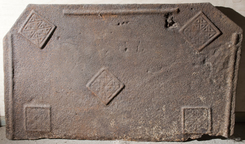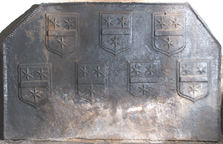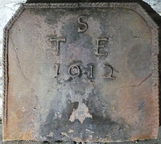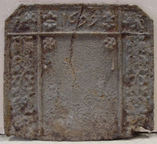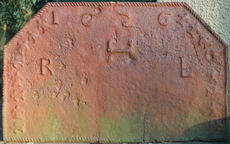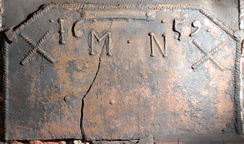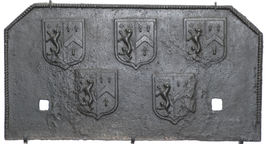-
1089
Description: Canted quasi-rectangular shape with no edging; straight length of ?dowel placed parallel to top and to each side; square stamp with fillet edge and four diagonally quartered squares repeated five times, three rotated with sides 45 degrees to the vertical in top corners and slightly left of lower centre, and two, unrotated, repeated twice in bottom corners.
Notes: The square stamps may be pastry moulds.
- Decoration tags:
- rectangular with canted top corners (shape)
- none (edging)
- simple stamps
- carved stamps
- objects
Manufactured: in the mid- to late-16th century in the Weald area of England.
Current location: Authentic Reclamation, Lymden Lane, Ticehurst, East Sussex, England.
- Attached to series:
- Crossed square Wealden series
- Food mould stamp firebacks
-
722
Description: Canted rectangular shape; twisted rope edging (top and sides); shield with recessed edges repeated seven times (3 and 4): a fess between three mullets of six points.
Notes: The arms are those of Courthope of Whiligh in Ticehurst; blazon: argent, a fess azure between three estoiles sable (two and one). Shown are molets of six points which have straight rays instead of (properly) estoiles which have wavy ones. However, the 1643/4 iron graveslab of David Barham of Snape, in Wadhurst church, has the same arms (also with molets instead of estoiles), which were those of his mother who was a Courthope.
Arms: Courthope, of Whiligh in Ticehurst
- Decoration tags:
- rectangular with canted top corners (shape)
- rope (edging)
- carved stamps
- heraldic
- armorial
Manufactured: in the late-16th to early-17th century in the Weald area of England.
Current location: in private hands, Ticehurst, East Sussex, England.
- Attached to series:
- Personal armorial firebacks
- Courthope arms series
-
1165
Description: Canted rectangular shape; braided rope edging (top and sides); top centre, initials 'TSE' in triad, above centred date.
Notes: The use of braided rope edging is unusual. The fireback was formerly in a house in Westmoreland associated with the Salkeld family.
Inscription: TSE [triad] / 1612
- Decoration tags:
- rectangular with canted top corners (shape)
- braided rope (edging)
- carved stamps
- individual letters
- individual numbers
- text
Manufactured: in 1612 in England.
Current location: Gwydir Castle, Trefriw, Conwy, Wales.
- Attached to series:
- Date & initials firebacks
-
714
Description: Canted rectangle; cavetto moulded edging (top and sides); single horizontal fillet below canted corners and vertical fillet parallel to each side, dividing the fireback into two side panels, two top corner panels, top panel and main central panel; corner panels, lion passant stamp, left facing in right corner, right facing in left corner; top panel, date between double fleurs-de-lys stamps; side panels, suspended vine stamp repeated each side; centre panel, flower head stamp in each top corner.
Notes: The lion, flower head and double fleur stamps and linear division are identical to those on a group of firebacks, some of which are identified by the initials IB. The vine stamp in the side panels is not seen on other backs in the series.
Inscription: 1699
- Decoration tags:
- rectangular with canted top corners (shape)
- cavetto (edging)
- carved stamps
- individual numbers
- heraldic
- text
- animals
- plants
Manufactured: in 1699 in the Forest of Dean area of England.
Current location: not known.
- Attached to series:
- IB series
- Date only firebacks
-
905
Description: Canted rectangle; fillet edging (top and sides); date to full width across centre of plate.
Notes: Bold, evenly-spaced numerals.
Inscription: 1680
- Decoration tags:
- rectangular with canted top corners (shape)
- fillet (edging)
- individual numbers
- text
Manufactured: in 1680 in England.
Current location: in private hands, Vauxhall, London, England.
- Attached to series:
- Date only firebacks
- 1680s Canted series
-
956
Description: Canted rectangle; twisted rope edging; date along the top; initials in triad across the middle; fleur-de-lys stamp repeated eight times down each side, pointing to the side or up in the order (from the top): side (2), then alternately, up first.
Notes: The initials probably represent those of a married couple, the 'H' for their surname; it is unusual for twisted rope edging to continue along the bottom of the plate.
Inscription: 1626 / RHL
- Decoration tags:
- rectangular with canted top corners (shape)
- rope (edging)
- carved stamps
- individual letters
- individual numbers
- heraldic
- text
Manufactured: in 1626 in the Forest of Dean area of England.
Current location: not known.
- Attached to series:
- Date & initials firebacks
- 1620s Dean series
-
725
Description: Canted rectangle with twisted rope edging; uneven, individually stamped letters and numerals, the initials separating the two parts of the date, which are raised slightly higher; dots are stamped on each side of each half of the date and between the initials; a twisted rope saltire at each end of the inscription.
Notes: The distinctive form of the number '5' has been seen on another fireback indicating a common source (no. 946). The plate above the inscription is a repair, as are the rivets either side of the crack.
Inscription: ·16· M · N ·59·
- Decoration tags:
- rectangular with canted top corners (shape)
- rope (edging)
- simple stamps
- carved stamps
- individual letters
- individual numbers
- apotropaic
- text
- objects
Manufactured: in 1659 in the Weald area of England.
Current location: in private hands, Upper Beeding, West Sussex, England.
- Attached to series:
- Date & initials firebacks
- Rope design firebacks
- Shortened '5' series
-
741
Description: Rectangular, with canted top corners; twisted rope edging (top and sides only); five shields of Ayloffe impaling Sulyard in two rows, 3-2; Ayloffe: sable, a lion rampant Or, collared gules, between three crosses formy of the second; Sulyard: argent, a chevron gules between three pheons inverted sable. Two cut notches probably for firedogs.
Notes: William Ayloffe (c1535-1584) of Bretons, Hornchurch, Essex, Justice of the Court of Queen’s Bench, married (c1560) Jane, dau. of Sir Eustace Sulyard, of Runwell, Essex. A large number of variants use the same shields. The excrescences affecting the left and right sides respectively of the lower shields are the result of inexpert ladling of the iron during casting. Part of the bequest to the Victoria and Albert Museum by Lieut. Colonel G. B. Croft-Lyons in 1926.
Arms: Ayloffe impaling Sulyard (William Ayloffe of Bretons, Hornchurch)
- Decoration tags:
- rectangular with canted top corners (shape)
- rope (edging)
- carved stamps
- armorial
Manufactured: in the early-17th century in the Weald area of England.
Current location: Victoria & Albert Museum, Cromwell Road, Kensington & Chelsea, Greater London, England.
Museum number: M.621-1926 (part of the Victoria & Albert Museum museum group)
- Attached to series:
- Ayloffe series
- Personal armorial firebacks
- Andiron slot firebacks
-
742
Description: Rectangular with canted top corners; twisted rope edging all round except base: plain plate with two stamps of an iron firedog with twisted neck and shield bearing letters HN and crossed staples; firedogs have columnar capitals; fleur de lys stamp repeated six times, singly at each end, in star pattern in middle; stamps have twisted wreaths.
Notes: The initials HN probably refer to Henry Nevill, the crossed staples being a badge of the Nevill family. Henry Nevill occupied Mayfield furnace from about 1585 until 1599. One of two variants (see no. 393) with the same firedogs and fleurs-de-lys; other firedogs in a very similar style are known.
Inscription: HN HN
- Decoration tags:
- rectangular with canted top corners (shape)
- rope (edging)
- simple stamps
- carved stamps
- heraldic
- text
- objects
Manufactured: in the late-16th century possibly at Mayfield Furnace in the Weald area of England.
Current location: Victoria & Albert Museum, Cromwell Road, Kensington & Chelsea, Greater London, England.
Museum number: 11.1900 (part of the Victoria & Albert Museum museum group)
-
748
Description: Fragment; right part only; canted rectangle; twisted rope edging; lion passant positioned vertically along right side; rose and crown stamp repeated twice (both over-pressed), each above an ‘imp’ figure with both arms lowered.
Notes: A particularly clear casting; the right rear leg of the lion (missing on some variants of this series) has been replaced by a short length of twisted rope.
- Decoration tags:
- rectangular with canted top corners (shape)
- rope (edging)
- carved stamps
- heraldic
- animals
Manufactured: in the mid-16th century in the Weald area of England.
Current location: Victoria & Albert Museum, Cromwell Road, Kensington & Chelsea, Greater London, England.
Museum number: 897.1901 (part of the Victoria & Albert Museum museum group)
- Attached to series:
- Royal series
